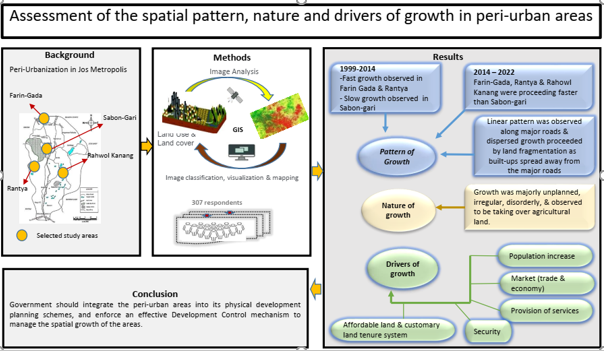Document Type : ORIGINAL RESEARCH ARTICLE
Authors
1 Department of Urban and Regional Planning, Faculty of Environmental Sciences, University of Jos, Nigeria
2 Department of Geography, School of Arts and Social Sciences, Aminu Sale Collage of Education Azare, Nigeria
3 Department of Urban and Regional Planning, School of Environmental Science and Technology, Federal Polytechnic, Mubi, Nigeria
4 Center for Research and Innovation, University of Maiduguri, Maiduguri, Nigeria
Abstract
BACKGROUND AND OBJECTIVES: One of the fascinating and complex realities of global development in the 21st century is urbanization. The present study focused on appraising the spatial pattern, nature, and growth drivers in selected peri-urban areas of Jos Metropolis. Accuracy assessment and classification of Landsat Satellite Images, evaluation of the spatial pattern of growth, the nature of growth, and the driving forces of growth were conducted.
METHODS: Data were collected through field observation and questionnaire administration, use of Remote Sensing and Geographic Information System, Global Positioning System, and camera. Satellite imageries used to identify the classes of LULC from 1999 to 2022 were Thematic Mapper (L5_TM) 1999, Landsat 7 ETM+ 2014, and Landsat 8 ETM+ 2022. GPS was used for Ground Truthing, and IDRISI Taiga software was used for image classification and area calculation. ArcGIS 10.1 used to visualize the satellite images and produce maps.
FINDINGS: Results revealed a definite growth rate pattern and land modification trends in the peri-urban areas over the study period. Between 1999 and 2014, fast growth was observed in Farin Gada and Rantya at 42.5% and 35.8% change, respectively; there was slow growth in Sabon-Gari at 7.0% proportion. From 2014 to 2022, growth in Farin-Gada (41.9%), Rantya (35.9%), and Rahowl Kanang (21.9%) proceeded rapidly with Sabon-Gari maintaining the least growth (0.3%). The study observed a linear growth pattern along arterial roads and a dispersed pattern proceeded by land fragmentation as built-ups spread farther from the road corridors. The nature of growth in the peri-urban areas was significantly unplanned, irregular, and disorderly and observed to be massively taking over agricultural land and swallowing up adjoining settlements. The study identified eight drivers that contributed to shaping and propelling growth in the areas.
CONCLUSION: The study recommended that the government should integrate the peri-urban areas into its physical development planning schemes and should enforce an effective Development Control mechanism to manage the spatial growth of these areas. The findings will help planners and policy-makers make informed and unified decisions beyond administrative boundaries. The study also adds to the body of knowledge globally and provides the bases for further research.
Graphical Abstract
Keywords
Main Subjects
OPEN ACCESS
©2023 The author(s). This article is licensed under a Creative Commons Attribution 4.0 International License, which permits use, sharing, adaptation, distribution and reproduction in any medium or format, as long as you give appropriate credit to the original author(s) and the source, provide a link to the Creative Commons license, and indicate if changes were made. The images or other third-party material in this article are included in the article’s Creative Commons license, unless indicated otherwise in a credit line to the material. If material is not included in the article’s Creative Commons license and your intended use is not permitted by statutory regulation or exceeds the permitted use, you will need to obtain permission directly from the copyright holder. To view a copy of this license, visit:
http://creativecommons.org/licenses/by/4.0/
PUBLISHER NOTE
IJHCUM Publisher remains neutral concerning jurisdictional claims in published maps and institutional affiliations.
CITATION METRICS & CAPTURES
Google Scholar | DOAJ | SCOPUS | EBSCO | Internet Archive |Twitter |Mendeley
CURRENT PUBLISHER
Tehran Municipality: Tehran Urban Research and Planning Center



Send comment about this article